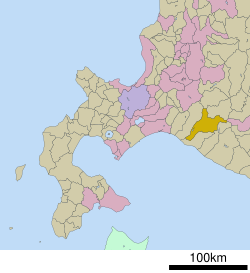Biratori
|
Biratori 平取町 |
|||
|---|---|---|---|
| Town | |||

Biratori Town hall
|
|||
|
|||
 Location of Biratori in Hokkaido (Hidaka Subprefecture) |
|||
| Location in Japan | |||
| Coordinates: 42°35′N 142°8′E / 42.583°N 142.133°ECoordinates: 42°35′N 142°8′E / 42.583°N 142.133°E | |||
| Country | Japan | ||
| Region | Hokkaido | ||
| Prefecture | Hokkaido (Hidaka Subprefecture) | ||
| District | Saru | ||
| Government | |||
| • Mayor | Yoshiteru Nakamichi | ||
| Area | |||
| • Total | 743.16 km2 (286.94 sq mi) | ||
| Population (September 30, 2016) | |||
| • Total | 5,305 | ||
| • Density | 7.1/km2 (18/sq mi) | ||
| Symbols | |||
| • Tree | Katsura (Cercidiphyllum japonicum) | ||
| • Flower | Lily of the Valley | ||
| • Bird | Great spotted woodpecker | ||
| Time zone | Japan Standard Time (UTC+9) | ||
| City hall address | 28, Honchō, Biratori-chō, Saru-gun, Hokkaidō 055-0192 |
||
| Website | www |
||
Biratori (平取町 Biratori-chō) (Ainu: ピラ・ウトゥル, translit. pira-utur) is a town located in Hidaka Subprefecture, Hokkaido, Japan.
As of September 2016, the town has an estimated population of 5,305 and a density of 7.1 persons per km². The total area is 743.16 km².
The Nibutani Dam was constructed in Nibutani (二風谷) district on the Saru River, though there was a strong objection due to a sacred meaning of the place for indigenous Ainu people. Nibutani is the site of the Ainu Cultural center. Nibutani's best known son is perhaps Shigeru Kayano, a 20th century advocate for the Ainu and Ainu language and culture. The Cultural Landscape along the Saru River resulting from Ainu Tradition and Modern Settlement within Biratori has been designated an Important Cultural Landscape.
Biratori is primarily an agricultural town, growing many different kinds of fruits and vegetables for people and livestock. Tomatoes are one of the top products of the town. It was also known for its lumber industry.
Other places of note in Biratori:
...
Wikipedia



